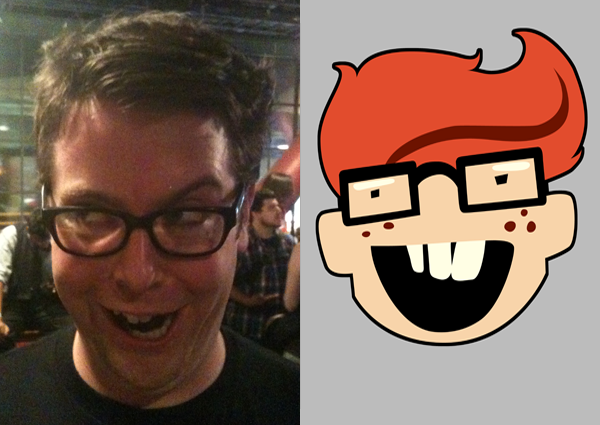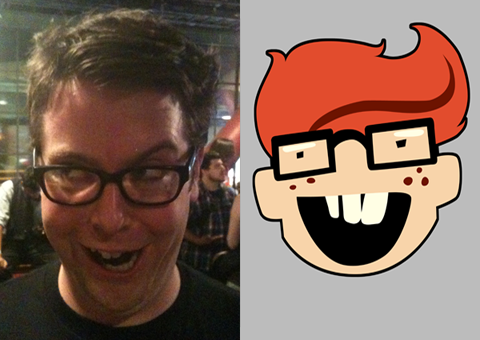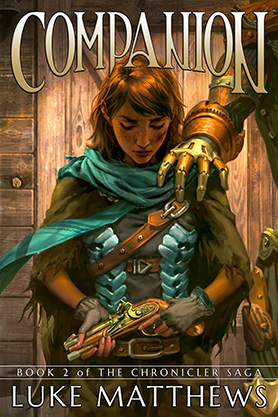Years ago, I had attended the first three Penny Arcade Expos and, being disappointed with them overall, stopped going. After finding out that they had moved from Bellevue’s Meydenbauer Center to the Washington State Convention & Trade Center in Seattle – and the attendance suddenly skyrocketed – I returned in 2008 and have been going back ever since.
I’ve been to a number of conventions in different cities, GenCon in Indianapolis being the largest. Nothing I’ve been to compares to PAX, especially for those of us with gaming in our blood (and no, I’ve not yet been to San Diego ComiCon). PAX is a self-described gaming “festival”, eschewing the normal industry/media drive in favor of focusing on gaming fans.
This year’s PAX Prime (as the Seattle PAX is now called after the addition of Boston’s PAX East in 2010) was my favorite so far, and is in heavy competition with GenCon as my favorite event of the year. I saw some amazing games, met some incredible people, and recorded three great podcast episodes available right here on www.geekerific.com.
FRIDAY
The first day of PAX is a whirlwind, where I try hard to plan out my day and invariably fail. This year my poor planning (and related apathy) caused me to miss the keynote address by David Jaffe. The upside to deciding against the keynote was that I had a relaxing breakfast with my wife before going into the hall, and didn’t wait in any lines that morning.
The Penny Arcade Expo never ceases to surprise me with its scale. Every year they find new nooks and crannies in the Convention Center to cram some sort of gaming nonsense into. I don’t think there was a single space that didn’t have some video game, tabletop game, vendor, panel, or jam-space stuck into it. I wouldn’t be surprised if they started running the smaller events in the larger restrooms next year.
In the middle of the day I attended IGN’s Game Scoop!: Don’t Hate Us Because We’re Beautiful panel, a live recording of one of my favorite podcasts featuring Greg Miller, Daemon Hatfield and Anthony Gallegos, and former IGNer Levi Buchanan. This particular show was a treat because everyone on the panel has had a direct influence on the Geekerific podcasts: Levi’s Retrocity podcast was an inspiration for After The Fact, Daemon and Greg’s presence on Game Scoop! and Beyond have had a big influence on our style, and Anthony and the Rebel FM crew (at PAX 2010’s How to Podcast Like a Pirate panel) inspired us to continue moving forward when we were contemplating shutting the whole thing down.
I had spoken to Greg online about being on one of our recordings during the weekend, and he graciously accepted the invite for our Saturday night show. Meeting him and the rest of the crew after the panel was a joy: everyone involved was friendly and down to earth, and I had the opportunity to bullshit with Levi and Anthony extensively. I can’t say enough about how nice these guys are. I grabbed a couple of VIP wristbands for that evening’s IGN Meet ‘n’ Greet at GameWorks (which will be important later) and we headed on our way.
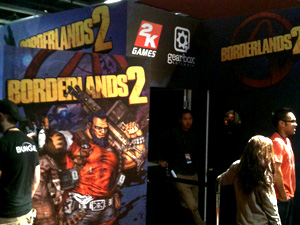 More than any prior year, the lines for demos were absurd. After making a first pass at wandering the hall, I started checking out wait times for some of the more high-profile titles like Uncharted 3, Borderlands 2, Skyrim, and Battlefield 3, many of which exceeded a 3-4 hour wait. Please pardon my language, but fuck that noise.
More than any prior year, the lines for demos were absurd. After making a first pass at wandering the hall, I started checking out wait times for some of the more high-profile titles like Uncharted 3, Borderlands 2, Skyrim, and Battlefield 3, many of which exceeded a 3-4 hour wait. Please pardon my language, but fuck that noise.
I’ve never been able to justify waiting that long in a line for a single viewing, especially when the hall is only open for 8 hours each day. The longest line I waited in this year was for a free OnLive micro-console, which took around 30 minutes. Instead, I stuck to playing games with short lines, and spent an excessive amount of time in the indie games area.
I just don’t need to wait that long for a 10-minute demo of a AAA title, especially not a sequel (and particularly not for Borderlands 2’s non-playable demo). I already know I’m going to buy Uncharted 3 and Borderlands 2, so my time is better spent seeing games that aren’t already blowing up the internet. I spent some real quality time with Ratchet & Clank: All 4 One (which my wife and I are extremely excited to play through co-op), Snapshot, Fez, and Closure.
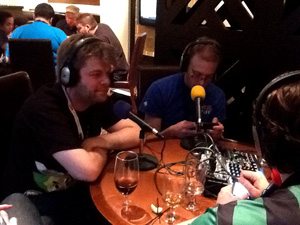 After the hall closed at the end of day 1, myself and the Geekerific crew – Mike “Mikeatron” DiPetrillo, Andy Podell, and Mathew Coyne – hopped over to the Sheraton to record the first of the Geekerific PAXCasts before heading out to the IGN party. We had no guests for the first night, but the recording was a ton of fun (as our PAX shows always are). You can check out the results of that night HERE.
After the hall closed at the end of day 1, myself and the Geekerific crew – Mike “Mikeatron” DiPetrillo, Andy Podell, and Mathew Coyne – hopped over to the Sheraton to record the first of the Geekerific PAXCasts before heading out to the IGN party. We had no guests for the first night, but the recording was a ton of fun (as our PAX shows always are). You can check out the results of that night HERE.
Afterward we headed to GameWorks, where we were told that the party was full and only those with VIP wristbands were being admitted. Earlier we had been told that the wristbands were strictly for skipping the line, but that anyone could get into the show. Having acquired wristbands for myself and my wife earlier in the day, we were able to get in but the rest of the crew was not. It sucked – I really wanted Greg to meet the whole crew before being on the show – but the guys were very gracious about my wife and I going in and they found other plans. The Geekerific guys rock my socks every single day.
The party was awesome. I met a bunch of people I’ve only met online previously (most notable of which is Brad Beach, a Twitter follower whom I met through MyIGN) and had a chance to mingle more with the IGN guys. The line for the bar was atrocious, which led to my first major mistake of the evening: deciding to double-fist Long Island Iced Tea’s because I didn’t want to get back into the line. Before I got too terribly lit I met Casey Lynch, the new Editor-in-Chief of IGN. I mentioned to him that Greg was going to be in our show the next day and, much to my surprise and delight, he offered to join in as well. I guess drunkenness did at least one good thing for me that evening.
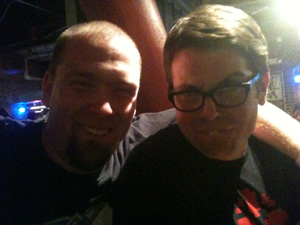 The rest of the night is a blur of unconnected imagery. At one point I was getting e-mail addresses from everyone I met – I guess I didn’t want to lose touch with people. I vaguely remember making a some sort of joke comment at Brad and Brittney Brombacher that apparently flopped hard (I don’t know what I said, but I have a snapshot in my mind of the look on her face), and I remember annoying the crap out of Daemon Hatfield while he was trying to talk to someone else. Apparently I stopped by my office on my way home to grab business cards, an event that I only have a vague, dreamlike recollection of. The rest of the night is pretty much gone.
The rest of the night is a blur of unconnected imagery. At one point I was getting e-mail addresses from everyone I met – I guess I didn’t want to lose touch with people. I vaguely remember making a some sort of joke comment at Brad and Brittney Brombacher that apparently flopped hard (I don’t know what I said, but I have a snapshot in my mind of the look on her face), and I remember annoying the crap out of Daemon Hatfield while he was trying to talk to someone else. Apparently I stopped by my office on my way home to grab business cards, an event that I only have a vague, dreamlike recollection of. The rest of the night is pretty much gone.
I would be the biggest idiot in the world if I didn’t take a moment here to profusely thank my beautiful and wonderful wife, who not only put up with my antics all night, but did so completely sober and acted as my designated driver. She’s the most amazing woman I know, and I am consistently surprised by the fact that she’s stuck with me for over 13 years. Thank you, sweetheart.
SATURDAY
Waking up on Saturday was like being dunked in a swimming pool when you don’t expect it. My vision was blurry, the pressure in my head was astounding, and drinking even fresh bottled water tasted like I was licking the floor of a public shower. My stomach rolled around under my ribcage as though trying to escape, and my throat was constantly singed by little spurts of bile. Not my finest hour.
Naturally, I got a very late start on Saturday, since I still hadn’t posted the previous night’s podcast. After assembling and posting the show, we finally reached the hall at a crisp 12:45, and spent the remainder of the day just wandering with no particular goal. I made the decision to forgo that day’s Seattle Sounders home game versus the Columbus Crew (we’re season ticket holders), and found out quickly how big that mistake was: the Sounders routed the Crew in a 6-2 drubbing. C’est la vie.
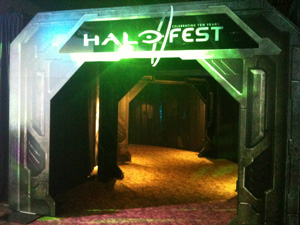 We finally spent some time at HaloFest, the huge party and exhibit hall put on by Microsoft in celebration of Halo’s 10th anniversary. I’ve always liked the Halo games but I’ve never been a humungous fan, so HaloFest was only mildly interesting, and in all was somewhat underwhelming. Granted, I didn’t stay for the presentations or competitions. The statues and dioramas were fun and the history wall was a neat stroll down memory lane, but one trip through was enough.
We finally spent some time at HaloFest, the huge party and exhibit hall put on by Microsoft in celebration of Halo’s 10th anniversary. I’ve always liked the Halo games but I’ve never been a humungous fan, so HaloFest was only mildly interesting, and in all was somewhat underwhelming. Granted, I didn’t stay for the presentations or competitions. The statues and dioramas were fun and the history wall was a neat stroll down memory lane, but one trip through was enough.
Saturday at PAX is by far the most insane. The crowds are the largest, the events are the biggest, and the lines are the longest. Navigating through the hall is a chore, especially when one of the larger booths is doing a presentation or giveaway. I’m amazed at the things gamers will do for an ill-fitting (but free!) t-shirt. Props go to Bethesda for their booth design, which incorporated a presentation stage and a large open space where fans could stand out of the way during these events. Good on ya, Bethesda.
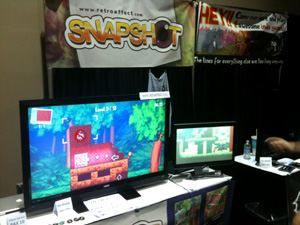 Yet again I spent a large portion of my day in the indie games room. I was completely enthralled by Snapshot, a gorgeous sprite-based 2-D platformer with a cool twist: you can take a picture of parts of the environment, which can then be moved to other parts of the environment to gain an advantage. You can make yourself new platforms or pathways, or even catch an enemy’s ranged attack and send it back at them (or toward another enemy). I’m looking forward to this game more than just about any I saw there.
Yet again I spent a large portion of my day in the indie games room. I was completely enthralled by Snapshot, a gorgeous sprite-based 2-D platformer with a cool twist: you can take a picture of parts of the environment, which can then be moved to other parts of the environment to gain an advantage. You can make yourself new platforms or pathways, or even catch an enemy’s ranged attack and send it back at them (or toward another enemy). I’m looking forward to this game more than just about any I saw there.
I was also very taken with Fez, a puzzle/platformer where you’re climbing a 4-sided tower. When you’re platforming you move in a 2-D plane, but you can rotate the entire viewpoint so that features on other sides of the tower can become new platforms or obstacles. It’s a little hard to describe, but a great execution. I was disappointed to find out that it has been in development for over five years and still doesn’t have a publisher, but hopefully being part of the PAX 10 this year will help rectify that.
It was on this second day that I also noticed Aurora Chaser, a multiplayer chase game where players control origami birds in a game of keep-away with some sort of jewel item (sounds stupid but my description doesn’t do it justice – the multiplayer was great) and RetroGrade, a shooter/rhythm game that reminded me somewhat of Frequency.
Due to my shortened day I didn’t get to see as much as I wanted to, and I had to bail on the hall just before 6 to set up for the day 2 Geekerific PAXCast. Casey and Greg are the highest-profile guests we’ve ever had on our little ghetto podcast, and I wanted to make sure we avoided any hiccups. To their credit, both of them were right on time in spite of very busy schedules. Greg mentioned that, of the 4 shows he had done that day, ours had the most professional setup, which came as a big surprise. I’ve always thought of our podcast kit as a bit of a guerrilla setup, but after hearing how the other shows were recorded I’m surprised that our kit is the nicest. Hopefully that comes through in our quality.
Greg and Casey were a delight to have on the show. Both of them were extremely friendly, gracious, and humble, and they not only put up with our lack of structure but rolled with it extremely well, creating an entertaining show out of almost nothing. And it was this show where I learned a valuable podcasting lesson.
I intended to leave this show freeform – to engage them in a more informal conversation, rather than turn the show into a interview. I wanted them to be comfortable just bullshitting with us as gamers. I found out that, while it mostly worked out for us, I should have had at least a few questions prepared for those lull moments where either I brain farted (which happened a couple of times) or we couldn’t think of the next topic.
While all of us there were amiable and generally of the same mindset, it became clear to me that we weren’t used to each others’ cadence and humor. Jokes that play well on After The Fact fell flat because Greg and Casey weren’t “in”, and the same sometimes happened with comments that would have flown like the wind on an episode of Beyond. Still, everyone involved had a great time. I can only hope that comes through in the show. This episode can be found HERE.
Saturday night reminded me of why I love conventions like this. A group of friends and Geekerific crew all went down to P.F. Chang’s for dinner, where we sat for almost two hours bs-ing about the convention and discussing the future of the website. This meal and that company are the highlight of my PAX this year.
SUNDAY
 Sunday was our day to make a concerted and organized push through the exhibit hall. My wife led the way, purposefully winding a planned path that allowed us to see every booth in the hall and decide where we wanted to stop. Even so, we didn’t play a whole lot of games. I watched quite a few that caught my attention – Lollipop Chainsaw, a Suda51 action game where you play as a chainsaw-wielding cheerleader hacking up zombies – topping that list. We collected cookies from the matronly ladies at the Good Old Games booth, watched people play Torchlight II (which may be the first PC game I purchase since Halflife 2), and found the small kiosks where EA was demoing the new SSX (drool).
Sunday was our day to make a concerted and organized push through the exhibit hall. My wife led the way, purposefully winding a planned path that allowed us to see every booth in the hall and decide where we wanted to stop. Even so, we didn’t play a whole lot of games. I watched quite a few that caught my attention – Lollipop Chainsaw, a Suda51 action game where you play as a chainsaw-wielding cheerleader hacking up zombies – topping that list. We collected cookies from the matronly ladies at the Good Old Games booth, watched people play Torchlight II (which may be the first PC game I purchase since Halflife 2), and found the small kiosks where EA was demoing the new SSX (drool).
I was surprised by a heavily stylized hack-n-slash action game called Vampire Smile – partially by how fun it was and also by how empty their demo kiosk was. SkyDrift, an airplane racing game for PSN & XBLA, had very complex controls, but it seemed fun and would be rewarding once mastered. Rayman Origins looks amazing, especially in multiplayer, and I’m extremely happy to see Ubisoft giving Rayman the proper high-res 2-D sprite treatment that popularized the franchise in the first place.
In the middle of the day we headed over to the Sheraton for what has become my favorite recurring panel at PAX, the Pitch Your Game Idea panel. Not even remotely serious, this panel involves people pitching the most ludicrous game ideas to a panel of judges who proceed to heckle them for their idiocy ala The Gong Show. Moderated by Jeff Kalles, this is invariably one of the funniest panels every year.
The last couple of hours of the exhibit hall was our chance to have another pass through the indie games room. I went back to some of my favorites like Snapshot and Fez, but also took a closer look at Jamestown, a fast-paced top-down shooter with old-school graphics; Word Fighter, an iPad game that mixes Boggle with Puzzle Fighter mechanics; and The Splatters, a puzzle game that reminded me of a cross between World of Goo and Peggle.
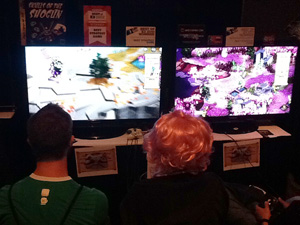 Probably my favorite game in the room on Sunday, though, was a turn-based strategy game on XBLA called Skulls of the Shogun. The makers of Skulls are huge fans of turn based games like Advance Wars and Fire Emblem, but wanted to create a title free of the limiting grid-based mechanics. The result is a game with much more freedom of movement and troop placement. The art style in Skulls is excellent and the game looks clean and polished. I can’t wait to get this one on my Xbox.
Probably my favorite game in the room on Sunday, though, was a turn-based strategy game on XBLA called Skulls of the Shogun. The makers of Skulls are huge fans of turn based games like Advance Wars and Fire Emblem, but wanted to create a title free of the limiting grid-based mechanics. The result is a game with much more freedom of movement and troop placement. The art style in Skulls is excellent and the game looks clean and polished. I can’t wait to get this one on my Xbox.
We went back into the hall for one last look in the last half-hour or so, and my wife went on a swag-collection frenzy. The last 10 minutes of the exhibit hall on Sunday is crazy, with every booth trying to unload as much of their crap as possible before everyone leaves. This resulted in a hat-full of pins and a ton of posters for us, which we’ll likely be sifted through and either thrown or given away.
The closure of the hall brought on the final PAXCast recording of the event, this time with special guest Jeff Kalles of Penny Arcade (moderator of the aforementioned Pitch Your Game Idea panel). Jeff and I met through co-workers and poker, and have been friends for several years now. It’s always a delight to have him on the show – even when he’s exhausted – and this year was no different. The final PAXCast is my favorite of the event – funny, topical, and entertaining, and I’m glad we were able to do it. You can get this episode of the show HERE.
CLOSURE
The end of PAX is always bittersweet for me. It’s probably the most fun weekend of my year, but it’s extremely exhausting, even though I’m only there as a fan. It’s fast paced and energetic, and I have even more on my plate now that I’ve started podcasting and blogging about it. It’s now over 36 hours since the con ended, and I’m still not even close to recovered. Even so, I’ll miss this convention. I met some great people, hung out with local friends that I should really see more often, and saw the greatest event in the game industry come and go, all right here in my back yard.
At one point in my life I couldn’t imagine PAX prospering, and expected it to die an early death or be relegated to small, local-convention status. Now, after 11 years of explosive growth, I can’t imagine a year without PAX. It may change as the game industry grows and morphs, but I hope that it endures and continues to adapt to an industry about to undergo widespread upheaval. Stay awesome, Penny Arcade Expo, ‘cause Seattle would just be another city without you.
I leave you with this one final image, which Greg Miller was gracious enough to let me snap after showing him the logo for Geekerific.com:
